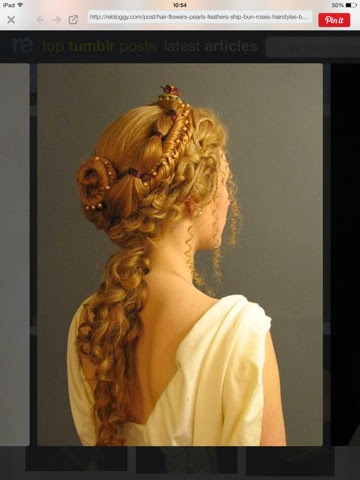By researching both Elizabethan Tudor women hairstyles and modern day styles it's given me a chance to see more of a contempory outlook on the era. In Elizabethan times I noticed that very rarely the portraits of women would have their hair down, although if it was young girls/virgins they would have their hair flowing down like this image of Elizabeth:

Most women had hair slicked back especially off their foreheads to mirror Elizabeth's style. This image here shows a heart shaped style using a veil. The sides have curls which have been pinned back to shape the face.

The older Elizabeth got I've noticed the more elaborate her hairstyles became. Here shows Elizabeth with a very tall barnet with many gems and jewels embroided into the hair.

Accessories like this were often used. This was called the French hood. It almost accentuates the forehead more as it looks amost further back. The middle parting was very fashionable at the time.

Tight, tiny curls were always used and this lady here has pearls and gems incouporated into her hair.

Pearls were expensive and symbolised purity and richness. Elizabeth wore hers over the years regularly.

Often the fabric from clothing was used in the hair also. This colour Elizabeth wears was an expensive colour to make and she wears it in her hair in bows.
This is an interesting image of Elizabeth, the hair is heart shaped with height around the sides whilst tight curls are coming down from her hair. The hair looks frizzy.

Some of the contempory images I found:
Here is a contemporary style which I found interesting it mirrors the similar shapes and twists/plats of Elizabethan times whilst having more of a modern day feel. the hair around the front looks similar to the last image of Elizabeth being frizzy curls. She has a fish tale plat running around the hair with a pony tail with ribbon thieving the pony tail into sections. There is a twist of a plat at the back with a waterfall effect of more glamorous curls coming down from the hair. I'd love to create something similar to this for our assessment. The hair also reminded me of Elizabeth's due to the colour and yellow flecks.
The hair in this photo includes a fluffy hairstyle which is almost messy. Plats are running from both ends of the face and pulled across the hair. Even though hair would not be over the face this still encourage rates plats and pinning like Elizabethan times.
This image reminded me of twists of Tudor women. I love the contempory style here which flows into a bun so effortlessly. Something suitable for bridal hair.
This image has slicked back hair forming into a braid-bun which I though was very clever. Because of the round style it reminded me of Elizabethan hair.
With plats running around the hair like this it reminded me of Elizabeth's plats I've seen.
Lastly something slightly more Tudor times; this hair style includes many techniques platting, twists, buns, use of pearls and ribbon/rope. I love the top part of the hair with twists and curls running into each other. This is another image I've been interested to take inspiration from and try on my model ready for our assessment.


























